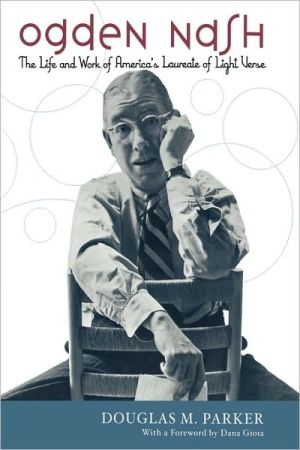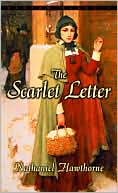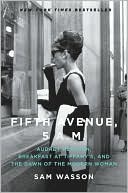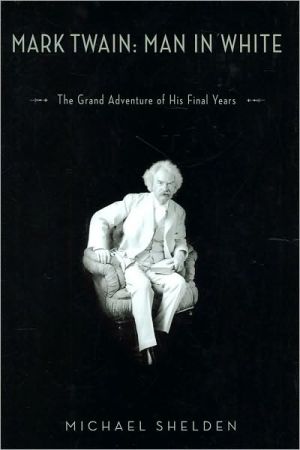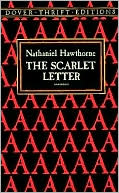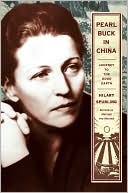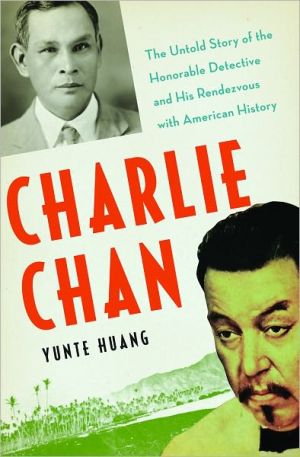Ogden Nash
His keen grasp of human nature and a unique style of verse made Ogden Nash, in the mid-twentieth century, the most widely read and frequently quoted poet of his time. For years, readers have longed for a biography to match Nash's charm, wit, and good nature; now we have it in Douglas Parker's absorbing and delightful life of the poet. Intelligent, informative, and engaging.... There is no comparable study not only of Nash's life but also of the role that poetry, especially comic verse, played...
Search in google:
Candy / Is dandy / But liquor / Is quicker. These inimitable lines could only have been written by Ogden Nash, the American nonpareil of light verse and one of the more remarkable figures in American letters. His keen grasp of human nature and a unique style of verse made him, in the mid-twentieth century, the most widely read and frequently quoted poet of his time. For years, readers have longed for a biography to match Nash's charm, wit, and good nature; now we have it in Douglas Parker's absorbing life of the poet. Mr. Parker has had exclusive access to family letters and diaries, and permission to quote liberally from them and from Nash's poems. He has written a warm and inviting biography of the poet who reveled in whimsy and wordplay, but who was applauded by his more serious contemporaries.Arkansas Democrate-Gazette"Parker tells this life story smoothly.... Nash's legion of fans should find themselves satisfied at this total story."
OGDEN NASH\ The Life and Work of America's Laureate of Light Verse \ \ By DOUGLAS M. PARKER \ IVAN R. DEE\ Copyright © 2005 Douglas M. Parker\ All right reserved.\ ISBN: 1-56663-637-X \ \ \ \ Chapter One\ THE EARLY INFLUENCES \ * * *\ Ogden Nash was born Frederick Ogden Nash, after his great-grandfather, Frederick Nash, who had been chief justice of the Supreme Court of North Carolina. Although Nash would adopt the less formal Ogden, or sometimes Og, he did have a strong sense of ancestry. A personal profile included in Nash's first book of poetry, Hard Lines (1931), proudly noted that he had "ten thousand cousins in North Carolina, his great-great-grandfather was revolutionary governor of the state, and the latter's brother, General Francis Nash, gave his name to Nashville, Tennessee." While the estimate of Nash cousins was exaggerated, the connection with the governor and the general (as well as the chief justice) was factual. Indeed, that heritage was a matter of considerable family pride, and one that usually found its way into newspaper reports of family weddings, births, and deaths.\ The governor, Abner Nash, had been born in Virginia, where his parents had immigrated from Tenby, Wales. His mother, Ann Owen Nash, was the daughter of Sir Hugh Owen, second baronet of Orielton (a heritage that would also be noted in family announcements). Abner Nash and his younger brother Francis, the future general, left Virginia in 1762 for Hillsborough, North Carolina, a town that would be a home to Nashes for several generations. (Reflecting his own interest in family history, Ogden Nash passed along to his children the explanation that the Nash brothers had left Virginia "because of their bad relations with their step-mother and disputes about inheritance.")\ Within a few years Abner Nash was elected to the North Carolina House of Commons, and after the start of the Revolutionary War he became the second governor of the new state. His experience as governor, however, was a troubled one. Opposition from Loyalists and from some of his own colleagues made it impossible for him to govern effectively and took a toll on his health. Moreover, the British seized and burned Pembroke, the plantation he had established on the River Trent near New Bern. As Nash's son, Frederick, later wrote of his father, "He went into the War of the Revolution a wealthy man and came out of it worth nothing-the latter I know by painful experience."\ Abner Nash declined a second term as governor in 1781 but served in the Continental Congress from 1782 to 1786, attending as regularly as his health would allow until his death from "consumption" during a session of the Congress in New York. It was an example of resilience and determination that was arguably a more valuable legacy to his descendants than the honor of his brief term as governor.\ Despite a promising start, the fate of Abner's brother, Francis, proved to be even more unfortunate. Francis Nash entered the war as a lieutenant colonel and by February 1777 had been promoted to brigadier general. Only eight months later, however, he was killed while commanding the North Carolina brigade in action against the British near Philadelphia. Nash was nonetheless considered a hero of North Carolina, and two years later, when settlers from that state built a log stockade overlooking the Cumberland River in Tennessee, they called it Fort Nashborough. When the settlement was renamed Nashville in 1784, Francis's place in history was secure.\ Meanwhile, Abner Nash's son, Frederick-Ogden's great-grandfather-had been born in 1781 at the governor's palace at New Bern. He grew up at Pembroke, after its recovery from the British, and despite the ruin of the plantation and the family fortunes, he was able to graduate from Princeton before returning to study law. As a young lawyer, Nash followed in his father's footsteps by serving in the state legislature, but after the loss of his first child he left New Bern for Hillsborough, seeking a healthier climate away from the coast.\ In Hillsborough, Frederick Nash reestablished a successful law practice and was later appointed to the Supreme Court of North Carolina. He became chief justice in 1852 and served in that capacity until his death in 1856. Frederick and his wife had seven children, of whom the fourth was Henry Kollock Nash. Henry also became a successful lawyer in Hillsborough, though he never reached the eminence enjoyed by his father and grandfather. Henry and his wife, Mary Simpson Nash, had five children, of whom the youngest was Ogden's father, Edmund Strudwick Nash.\ Edmund, born in 1854, grew up in Hillsborough and retained strong memories of the town throughout his life. He enjoyed recounting tales of his boyhood, and Ogden once told an interviewer that at the close of the Civil War his father had "patrolled the grounds of the family estate with a shotgun to protect his mother and sisters from stragglers and looters." Another family story, perhaps apocryphal, had it that Edmund, having watched Yankee soldiers make off with the family silver, was served with the same silver decades later at a dinner party in New York City. According to the story, he was too tactful to remark upon the irony in the presence of his host.\ While Edmund's older brother, Frederick, had followed the family tradition and become a lawyer, that did not appeal to Edmund. Disdaining higher education, he left Hillsborough in 1877 to seek his fortune in New York City. He soon took a job with Patterson, Downing and Company, a firm in the business of buying and selling naval stores, chiefly turpentine and rosin. The company had offices in Europe and Russia, and young Nash did a good deal of traveling. In 1882 he wrote his father a long letter from London describing his experiences and outlining his business itinerary: "Antwerp thence to Amsterdam & Rotterdam, Mainz, Berlin and Cologne. Then Hamburg, Stetin, Danzig, Warsaw, Riga, St. Petersburg & Moscow-leaving there I will go to Southern Europe, then to Paris, England again, Scotland and home. That is quite a trip isn't it?"\ And in February 1884, Edmund wrote his mother from St. Petersburg, describing his life there with evident delight:\ I wish I could for amusement and entertainment send you a picture of my daily life here. In the morning my agent calls for me in his sleigh and we visit the small firms with whom my business brings me in contact. I then lunch-in the afternoon I proceed in due state, enveloped in fur like an esquemaux, to the Royal Exchange where I parade, doffing and being doffed at every step, as solemnly as tho this was the chief business in life.\ Edmund's merry insouciance is eerily similar to the tone that Ogden struck in letters nearly fifty years later, when the son was also delighted by sudden success at an early age.\ As Edmund Nash's career progressed, he found time for occasional vacations, and he proceeded one year to a resort at White Sulphur Springs, West Virginia. There he met a beautiful young girl from Kentucky, Mattie Chenault, who would soon become his wife. While Edmund Nash could claim distinguished forebears, Mattie too came from a highly respected family, and she had an educational background that would later prove important.\ The Chenaults were believed to have been descended from Etienne Chenault, a French Huguenot, who had immigrated to America in 1701. Mattie's father, Jason, was an educator who had been born in Danville, Kentucky, and raised at Millwood, a farm outside Danville that had once been visited by Harriet Beecher Stowe and later became the setting for her novel Uncle Tom's Cabin. Although Jason attended Harvard for a year, he graduated from Centre College in 1861 and then took up the study of law. Conditions after the Civil War, however, made it difficult to establish a law practice, and Jason took a teaching position in Richmond, Kentucky. It was there, in 1868, that Mattie was born.\ After returning to Centre College to earn a master's degree, Jason joined its faculty. In 1875, however, he moved to Louisville and founded a prep school that became highly successful. Under her father's guidance, Mattie's own academic accomplishments won admission to Wellesley at the precocious age of fourteen. Although she dropped out of Wellesley before graduating, Mattie had become well prepared for the time when she would participate in the education of her own children. Long after his mother's death, Ogden noted that she "came from a very scholarly family" and spoke of how important her tutoring had been to him in his boyhood.\ Edmund Nash and Mattie Chenault were married on December 10, 1889, at Mattie's home in Louisville. The wedding was lavishly covered by the Louisville Courier-Journal. Headlines proclaimed that the Chenault drawing room had been "Made to Represent a Chapel With Picturesque Appointments" and that the ceremony had been witnessed by a "Brilliant Assemblage." The ensuing report described Mattie Chenault as "one of the belles of the city"-"beautiful, bright and accomplished." Continuing in the same breathless voice, it was noted that "society had been on the qui vive for weeks" and that "the spacious parlors, reception rooms and halls" of the Chenault home had been "crowded with a representative Louisville society gathering." The account of the wedding ceremony was flawed only by an amusing typographical miscue: the ceremony was conducted by two clergy, the first of whom, it was said, "made the anti-nuptial address." (It was the kind of "news break" that Ogden Nash's colleague on The New Yorker in 1931, E. B. White, would have gleefully quoted with a comment such as "But the ceremony went ahead anyway.")\ The Courier-Journal story also included a brief account of Edmund Nash's business success, noting that he was responsible for management of his firm's branches in Europe. In aid of those responsibilities, the paper said, the newlyweds would spend the winter in St. Petersburg and would then reside in London. St. Petersburg in the winter might not be every bride's idea of a place to honeymoon, but the Nashes were unquestionably off to a glamorous start.\ By some time in 1890 the Nashes had returned and established themselves in Greenwich, Connecticut, where a first child, Shirley Gwendolyn, "Gwen," was born on December 8, almost exactly one year after her parents' wedding. Two years later, Mattie went home to Louisville for the birth of the Nashes' next child, Eleanor. The Nashes' first son, Edmund Witherell, "Ted," was born in 1896 in Savannah, Georgia, where much of the naval stores business was conducted and where the Nashes had a winter residence. The Nashes' home in Savannah was a stately house on Lafayette Square rented from Juliette Low, founder of the Girl Scouts of America. (Since 1928 the house has been occupied by the Georgia Society of Colonial Dames. For many years the Society has published a cookbook to which Ogden Nash obligingly contributed an introductory poem. It began, "Pilgrim's Progress is a good book, and so, I'm told is Deuteronomy / But neither is to be compared with this epic of gastronomy.")\ In the meantime, Edmund's career continued to flourish, though not without some bumps along the way. In times of adversity, nothing was more important to Edmund than the love and support of his wife. In a letter written in 1894 to his children (then only Gwen and Eleanor, aged four and two), he asked that, if they should marry, they read two letters from Mattie to "learn how to give that comfort and strength which it is in the power of a good wife to bestow." Some years later, continuing the letter to his children, Edmund explained that Mattie's letter had been written at a time when his business had been "struggling through the deep waters." He had, Nash continued, "emerged strong and buoyant" to enjoy "many years of abounding prosperity."\ By the time Ogden was born, on August 19, 1902, the Nashes had moved from Greenwich to Milton Point in Rye, New York. The move made it more convenient for Mattie to visit her sister, Shirley, who, with her husband, Franklin Watkins, lived at Ramaqua, a large estate in Rye. Franklin Watkins was a friend of Edmund Nash, and according to his daughter, Shirley Watkins Steinman, he had acted in a "John Alden" role in Nash's initial courtship of Mattie at White Sulphur Springs. Later, Edmund and Mattie reciprocated by introducing Watkins to Shirley Chenault, and the families had a close relationship. Sometime after Ogden was born, they drew even closer when the Nashes moved to Rockledge, a home adjacent to Ramaqua. But as Edmund Nash's fortunes continued to improve and those of Franklin Watkins declined, the Watkins family left Ramaqua and rented it to the Nashes. Ogden was joined by a younger brother, Aubrey, born in 1904, and Ramaqua became the place of their most vivid childhood memories.\ The house at Ramaqua was a three-story structure, sometimes described as "Victorian-Italian," or, as Ogden later put it, "grotesque Victorian." Its most distinguishing feature was a tower where, according to legend, a former owner, a Mr. Loder, had hanged himself, and where his ghost would appear, clad in dressing gown and slippers. Aubrey Nash, however, always maintained that he was the only family member who had ever seen the ghost. Another story held that the house had once been connected to Long Island Sound by way of an underground tunnel used by smugglers, and Ogden and Aubrey spent many hours searching for it without success. The legends were less important to Edmund and Mattie than the fact that the house was well suited to the kind of gracious entertaining they enjoyed. (Describing life in Rye at the turn of the century, a 1955 history of the town noted that "The society columns contained frequent references to the Edmund Nash family....")\ The surrounding grounds were even grander than the house and were spread over more than fifty acres along the Boston Post Road. On the other side of the property lay the tracks of the New York, New Haven and Hartford Railway-whose commuter train would make a special stop to let Edmund off at the foot of his property. Rolling lawns led to woods, fruit trees, stables, and a carriage house. It was, in short, a wonderful place for young boys to explore and and to do all the sorts of things that young boys like to do. Ogden, it appears, developed an instinct for mischief at an early age; Aubrey would later recall a variety of pranks and adventures that he claimed his brother Og had instigated. Similarly, a youthful playmate of Ogden's remembered how he had tricked her into hitting a hornet's nest and showed no sympathy when she sought refuge from the angry hornets by plunging into a nearby pond. (The victim apparently forgave Nash. She recounted the incident in a letter requesting an autograph of one of his books for her son.)\ Ogden's own favorite memory of Ramaqua was sitting on the estate wall with Aubrey while identifying and counting the cars on the Post Road ("If we counted eight or ten we had a very high mark to be chalked up on the calendar"). Some sixty years later, Nash wrote a poem, "From an Antique Land," that recalled the names of the early cars, including his family's Royal Tourist and Pope Hartford. It also recalled an annual road race in Savannah that, Nash said, was a great event in his life and gave him the ambition-never pursued-to be a racing driver.\ (Continues...)\ \ \ \ \ Excerpted from OGDEN NASH by DOUGLAS M. PARKER Copyright © 2005 by Douglas M. Parker.\ Excerpted by permission.\ All rights reserved. No part of this excerpt may be reproduced or reprinted without permission in writing from the publisher.\ Excerpts are provided by Dial-A-Book Inc. solely for the personal use of visitors to this web site. \ \
Acknowledgments ixForeword Dana Gioia xiIntroduction 3The Early Influences 7Getting Started 23The New Yorker: In the Beginning 40Happy Days 61Writing Light Verse...in the Depression 75Hollywood Beckons 84At Home in Baltimore 100One Touch of Venus 113Lyrics by Nash 128The Children Grow Up 144Economics of Poetry: Selling the Wares 154From Radio to Lecture Hall to Television 167Laureate of the Age of Friction 177Another Day, Another Dolor 191Baltimore Redux and Little Boar's Head 204The Wise Owls of Forty-third Street 216Oh, to Be in England 238The Last Stanza 251The Nash Legacy 260Epilogue: The Family 264Table of Poems 267Bibliography 271Notes 275Index 301
\ Bookwatch"Multi-faceted biography covers all aspects...and is a 'must' for any Nash reader. "\ \ \ \ \ Books & Culture"Parker has done a tremendous service by writing this readable and workmanlike biography-the first biography of Nash, amazingly enough."\ \ \ Laurie Higgins"Affectionately honest. "\ —Upper Cape Codder\ \ \ \ \ C&RL News"Parker narrates Nash's accomplishments with careful detail, sprinkling apt verse excerpts throughout to add lyrical detail."\ \ \ \ \ Arkansas Democrate-Gazette"Parker tells this life story smoothly.... Nash's legion of fans should find themselves satisfied at this total story."\ \ \ \ \ Theresa BarnabyRichly detailed....[An] affectionate look at Nash's life.\ —Tri-City Herald\ \ \ \ \ Bloomberg.com"Well-researched."\ \ \ \ \ Publishers WeeklyThe life of the man who is fondly remembered for his verse "Candy/Is dandy/ But liquor/Is quicker" was often anything but dandy, according to his assiduous biographer. Ogden Nash's (1902-1971) genteel Southern heritage and one year at Harvard (due to his father's financial reverses) provided him with literary aspirations that led him to fear his jaunty, pun-filled, gently satiric verse was not real poetry. Even after acclaim greeted his frequent publication in the New Yorker, finances forced him to leave his beloved (and temperamental) wife and two daughters to go on the road as a lecturer and performer, where he often suffered bouts of intestinal illness and depression. His yearning for a career in musical theater was briefly (if memorably) fulfilled when he provided the lyrics for Kurt Weill's classic "Speak Low." Gratification came from unexpected sources, however, including a lifelong friendship with S.J. Perelman and the praise of W.H. Auden. Parker, a retired lawyer writing with the Nash family's cooperation, provides numerous examples of Nash's distinctive poetry, his wit underscored by gentle social commentary, antic wordplay and rhyme and meter that seemed random but was meticulously composed. Parker's is a useful, highly readable biography of one of America's best-loved poets. Photos. 12 b&w photos not seen by PW. (Apr. 29) Copyright 2005 Reed Business Information.\ \ \ \ \ School Library JournalAdult/High School-Parker paints a picture of a kind, loving man who made words and wordplay fun and entertaining. Even at the age of 10, Nash possessed a talent and an ability to use language cleverly. In 1930, Nash's poems made their appearance in the New Yorker, and this funny, talented writer became part of a literary landscape that included such luminaries as Dorothy Parker and S. J. Perelman. At first glance, Nash's verses seem simple, and yet they are filled with witty lines and twists on spelling. He liked to write about families, and no one was safe from his gentle satire, not even his beloved wife, Frances. Nash told the truth about the ordinary and, in doing so, endeared himself to a lifetime of readers. Would-be poets and satirists as well as students interested in the artistic milieu of the times will enjoy reading this well-written tribute.-Peggy Bercher, Fairfax County Public Library, VA Copyright 2005 Reed Business Information.\ \ \ \ \ Kirkus ReviewsAn authorized, entirely sympathetic account of the wildly popular humorist poet who composed as facilely for the New Yorker as for Hollywood and Hallmark Cards. In his day (1902-71), Nash was America's most prominent purveyor of snappy rhyming verse. Enjoying a fairly privileged childhood in Rye, N.Y., and in Savannah, Ga., where his father ran a prosperous business, he attended private school and then Harvard for a year, dropping out to make his way to New York. He worked at various publishing houses during the Depression, and his poems began to appear regularly in the Saturday Evening Post. His long association with the New Yorker began under Harold Ross and continued until his [Nash's] death; "the restorative Nashian couplet or clarifying stanza" (as Roger Angell described it) attracted just the sort of readership the magazine wanted. Still, Nash struggled to make a living, keep wife Frances in comfort, and raise two daughters, both of whom became talented writer/illustrators. He worked briefly in Hollywood as a screenwriter (without credit) on The Wizard of Oz, and he had some success as a Broadway lyricist, most notably for Kurt Weill's One Touch of Venus in 1942. But exhausting reading circuits were more lucrative, though they ruined his health. The tireless Nash also wrote children's books and made frequent appearances on such TV shows as Masquerade Party. Retired lawyer and neophyte biographer Parker's cheery work presents Nash's life as straightforward and blameless-much like his poetry, which gently satirizes family issues, politics, and human foibles. But the author's lack of training in literary history means that his account somewhat scants the ideas and currents that buoyedNash. Perhaps, in the end, a light poet doesn't lend himself to psychoanalysis. The ample quotations from Nash's poetry are certainly a pleasure. Proficiently recognizes and restores an important American voice.\ \
